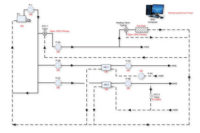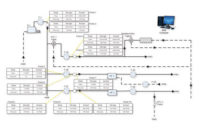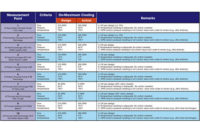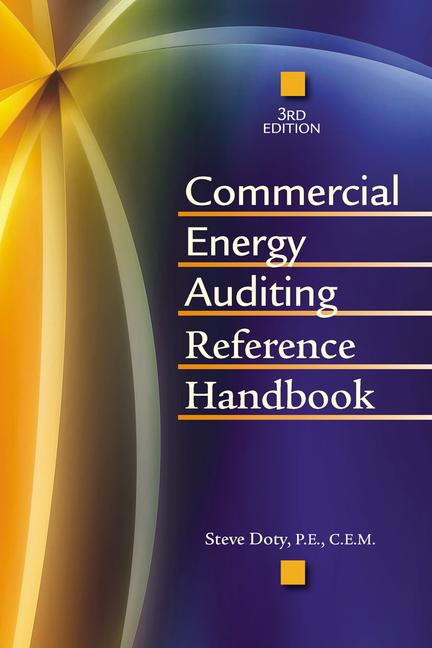We are at month three of this B2B energy retrocommissioning test series. Months one and two were devoted to data collection, data analysis, and solution planning, and we are now at the solution implementation phase. Using the existing system ATC/FPT system flow diagram for this test, we have identified and incorporated the following energy conservation features from the completed energy retrocommissioning solution plan (full report not included in this test):
• ECM-1: Close off the individual unit ventilator outdoor air dampers making each terminal unit a 100% recirculated unit ventilator
• ECM-2; Add a direct outdoor air system (DOAS) with heating, cooling, dehumidification, energy recovery, and more efficient air filtration of outdoor air connected to the back of each unit ventilator
• ECM-3: Add energy recovery coils and filters to associated room exhaust fans
• ECM-4: Replace three-way valves with two-way valves and VFD pumping
• ECM-5: Add occupancy sensors to classrooms
•ECM-6: Replace antiquated pump motors with high-efficiency motors
• ECM-7: Resize heating and cooling pumps using hydraulic modeling of existing water systems
With the energy conservation initiatives agreed upon above, the energy retrocommissioning team will implement these enhancements, and the existing automatic control system will be replaced with a direct digital computerized BAS computer to monitor, measure, and benchmark the past energy performance to the new high-performance energy retrocommissioned system.
Leading up to the energy retrocommissioning test, the TAB engineer shall rebalance the chilled water and hot water systems and document the results in the TAB system flow diagram at the following operating conditions:
• Deadhead the pump to reconfirm the correct pump impeller
• Maximum design water flows
• Minimum design water flows
Note: under each mode of operation, the TAB professional shall document the appropriate flows, velocities, and pressure drops throughout the TAB software program (refer to last month’s B2B TAB system flow diagram for an example). Each of these flow diagrams will be included in an ATC/FPT/TAB operator handbook that will be put in a three-ring binder and placed at the central chiller and boiler for quick reference in the future.
This month’s test requires you to refer to the new sequence of operation based on the energy conservation measures noted above and as shown in the ATC/FPT system flow diagram on page two of this B2B test. This new ATC sequence has been inputted into the functional performance test (FPT) retrocommissioning CX-3 software, with the “reaction” device-by-device embedded into the checklist below the flow diagram. It is your task to check off the “pass” activities as you verify this energy retrocommissioned system ATC/FPT. The answers can be found at www.esmagazine.com.
The sequences selected are for this month’s test is focused on the waterside of this retrofitted application and are: Off-Fail-Safe Conditions, On-Maximum Cooling, and On-Maximum Heating. For this system, there will be other sequences of operation plus verification of alarms and safeties that are not part of this B2B test. In the next series of B2Bs, we will focus on the airside for K-12 school building unit ventilator system application.
The commissioning engineer’s ATC/FPT system flow diagrams, sequence-by-sequence of operation results shall be included in this operator handbook with the TAB design-to-actual results. Operating instructions will have occurred prior to the energy retrocommissioning implementation project and during the retrocommissioning of the systems. Here again, the operator handbook being provided from this energy retrocommissioning initiative will include the current BofD document to ensure future reference data is available for any new operating personnel and to recommission this system.
The CMMS system operator should update her asset database and PM workorders to ensure these units will receive the required care based on new components and equipment. See “The Facility Files” column for a sample PM workorder for a unit ventilator.
As part of the project closeout, existing record drawings should be updated with the additions, deletions, etc., to these systems. The team should also submit the necessary paperwork for any available utility company rebate(s) having received early approval of the utility rebate incentive in the solution plan phase of this project.
At the project closeout meeting, the monitoring, measuring, and benchmarking assignment should be made and a monthly reporting system mutually agreed upon by the energy retrocommissioning team so that there is a method to assess the work and also look for new ways to improve these water systems performance. The team should also have on their meeting agenda a lessons-learned discussion to make sure all documentation is completed, an electronic copy of the entire energy retrocommissioning report is on file, system training is completed, and the PM workorder system is current. In addition, these lessons-learned sessions should assess how to do this better next time, what worked and didn’t work relative to the solution implementation phase, and any new energy retrocommissioning project opportunities.








